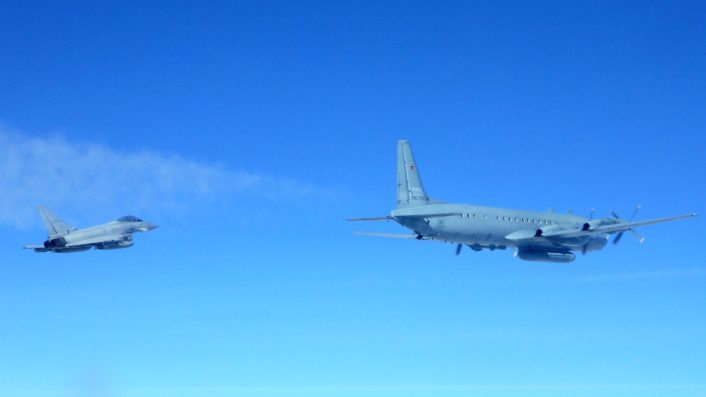The Fighterbomber Telegram channel, known for its ties to the Russian Air Force, shared routine images of Italian Air Force Eurofighter Typhoons flying over the Baltic Sea. These relatively ordinary photos, however, sparked sensationalist reports in the Italian media.
On Oct. 18, 2024, the popular Russian military-affiliated Telegram channel “FighterBomber” shared on social media some close-up photos of Italian Air Force Eurofighter Typhoons flying over the Baltic Sea off Kaliningrad. “In the Kaliningrad special region everything is quite stable,” the post reads. “Italian Eurofighters came to see our beautiful planes and show off.”
In a sarcastic tone, the post goes on to say: “I wonder if they are here for the 2% daily allowance and if their Italian backers have run out of money in their bank accounts for business travel and to pay for staff accommodation.”
Nothing special actually: the famous Russian milblogger often posts images of NATO aircraft taken by Russian pilots during close encounters all around the world, in the same way as NATO posts images of Russian aircraft intercepted in international airspace during routine air policing missions.
Just one week before the Russian photos emerged, NATO Allied Air Command released a cool selfie taken by an Italian Eurofighter pilot with two Russian MiG-31 Foxhound jets intercepted over the Baltic region.
Nevertheless, what was truly surprising was the reaction from several major Italian mainstream media outlets to those photographs. For example, LaRepubblica.it, the second most-read news website in Italy, published a report titled: “Kaliningrad, high-altitude photos: the Russian message to the Italian fighters.”
Aside from some inaccuracies—such as the article incorrectly stating that the Eurofighter was equipped with a Reccelite pod, when in fact it was a Litening pod—the Italian media outlet interpreted a hidden message in the Telegram post by FighterBomber:
The short text released by the Fighterbomber channel – which has over half a million subscribers – uses sarcastic words towards the Italian pilots and the allowances paid to NATO soldiers on missions. And it shows how Putin’s intelligence files not only the aircraft but also the officers involved in these deployments.
While Russian intelligence may indeed have an interest in tracking Italian assets and personnel, it’s unclear how those photographs would aid such efforts.
Other Italian outlets (Il Giornale, among them) have posted similar reports with the same narrative.
What the Russian photos show
The Russian photographs show two Eurofighters, one of those, based on the markings and insignia, clearly belonging to the 51° Stormo (Wing) based at Istrana Air Base. The jet is the standard Air Policing configuration, that includes two fuel tanks, two IRIS-T and two AIM-120 Air-to-Air Missiles, as well as the already mentioned Litening targeting pod.
The Italian aircraft is one of the four deployed to Lithuania since August 2024 as part of the Task Force Air (TFA) 36th WING “Baltic Thunder II” to support NATO Baltic Air Policing mission. Operating out of Šiauliai Air Base, the Task Force includes Eurofighter Typhoon (F-2000 in accordance with the Italian MOD Mission Design Series) aircraft from the 36th Wing at Gioia del Colle, the 4th Wing at Grosseto, the 37th Wing at Trapani, and the 51st Wing at Istrana. These forces are complemented by specialized assets (G.550 CAEW and Beechcraft 350 SPYDR) from the 14th Wing at Pratica di Mare, focused on intelligence-gathering operations. The Task Force’s mission began with the attainment of Full Operational Capability (FOC) on Aug. 1, 2024, and it is set to continue through March 2025.
As explained multiple times, NATO Air Policing is a collective defense mission designed to maintain the security of the Alliance’s airspace around the clock. It ensures a constant presence of combat aircraft and crews, ready to respond swiftly to any potential airspace violations. The mission’s goal is to safeguard NATO members’ skies and deter any threats to their security.

Specifically, BAP (Baltic Air Policing) has been operational since April 2004 and involves the protection of the airspace over Estonia, Latvia, and Lithuania. Seventeen NATO allies have participated in this mission, which reinforces the collective commitment to maintaining a strong, unified defense posture in the region.
Italy has played a significant role in these efforts, with nine deployments since 2015, contributing more than any other nation. In addition to Baltic Air Policing, Italy has also supported NATO’s air defense missions over Iceland, Romania, Bulgaria, Poland, Albania, and Montenegro, reflecting its broader commitment to the security of the Alliance.
As of October 8, 2024, the Italian Air Force detachment had logged 500 flight hours and 20 Alpha Scrambles (alert launches of the fighters in QRA – Quick Reaction Alert).
Beware of Sensationalism
The sensational use of photographs, especially in military contexts, can distort facts and fuel false narratives. A prime example is the 2021 close encounter between an Italian F-35A and a Russian Su-30SM during a NATO air policing mission. Over time, this event has been repeatedly misrepresented, with exaggerated stories and fabricated quotes, such as claims that the Italian pilot “froze with fear,” leading to a nervous breakdown. These narratives, often unsupported by facts, show how easily images can be manipulated to create sensationalist or propagandist stories.
The key takeaway is to always verify the context and facts behind military photos and avoid falling for exaggerated or fabricated accounts. Stick to verified reports and be cautious of speculative or sensationalized content.



